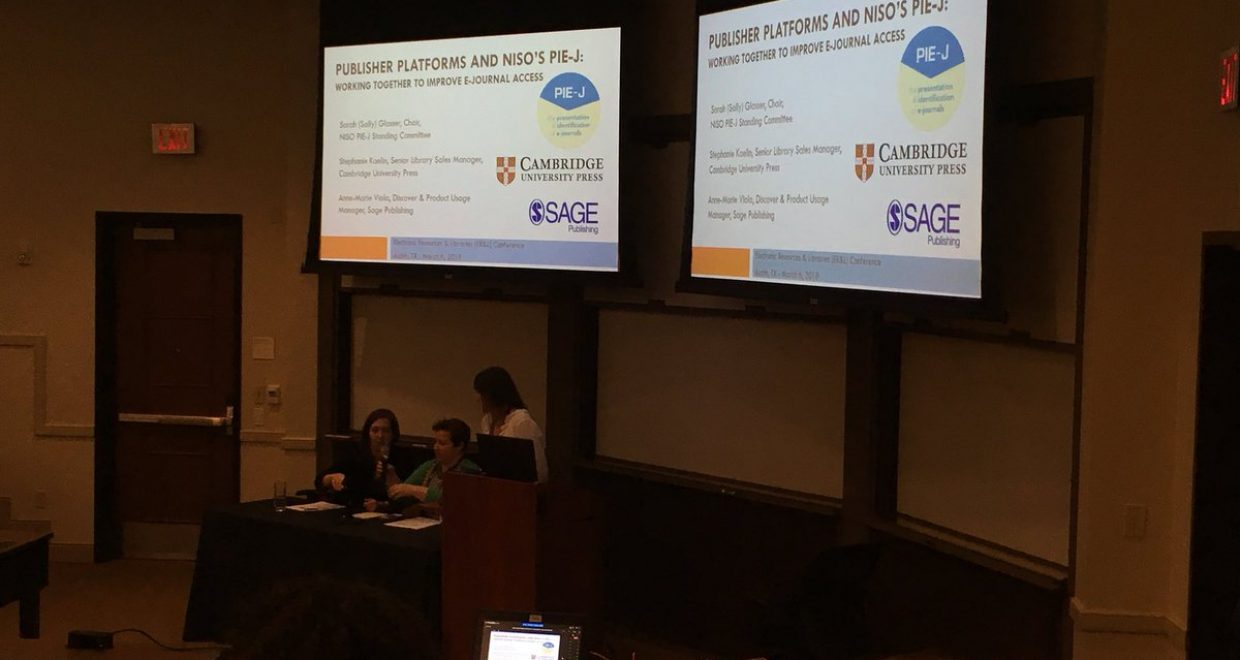Report from an ER&L 2018 session on PIE-J, featuring Cambridge’s Stephanie Kaelin
Senior Library Sales Manager Stephanie Kaelin participated in a panel at the 2018 ER&L meeting in Austin, Texas, entitled “Publisher Platforms and NISO’s PIE-J: Working together to improve e-journal access”. The 45-minute session also featured Anne-Marie Viola, Discovery & Product Usage Manager at SAGE Publishing, and Sarah (Sally) Glaser, Serials/E-Resources Librarian at Hofstra University and Chair of the NISO PIE-J Standing Committee.
Sally started the session by summarizing what PIE-J is. If you don’t know, PIE-J stands for the ‘preservation and identification of e-journals’. This set of guidelines for journal providers includes recommendations for how title changes and ISSN histories should be arranged online, to enable better discovery and correct citations.
The best practices include associating journal articles, issues, and volumes under the originally-published title, and constructing the site’s ‘cite as’ feature to use the title under which the content was originally published. New ISSNs should be requested for each title change; also, the journal’s print and electronic versions should have separate ISSNs.
These recommendations benefit the entire academic ecosystem. For publishers, site traffic increases; title counts grow; and user satisfaction rises. For librarians, there is increased OpenURL link success; better alignment with the library’s catalogue; and greater patron satisfaction. For researchers, frustration is reduced; material is more easily located; and citations can be done correctly.
Sally then introduced the other speakers, who explained their organizations’ experiences with implementing PIE-J.
Stephanie went through the evolution of Cambridge’s handling of journals with previous titles. When Cambridge Journals Online (CJO) launched in 1997, the same internal identifier was used for both older and current titles of a journal. Each identifier meant a homepage was created, so the current title’s information basically overwrote the older one(s). This was done due to technical limitations of the time, and because one homepage was considered preferable to multiple pages for the same journal.
After the launch of Cambridge Core in September 2016, for any journals new to Cambridge that had prior titles, each title was assigned its own identifier, so each had its own homepage.
Then, in December 2017, further Core development enabled each of a journal’s titles to be housed together on a ‘journal hub’ homepage, in addition to each having its own page. Now, all titles are shown together; each is also discoverable on its own; and links have been established among all. Searches for any of the titles include all in the search results, and each citation uses the journal’s title correctly, so researchers have a better user experience.
Cambridge is nearly finished with its PIE-J implementation. Covers were not always kept throughout the journal’s lifetime, so any missing are being sourced. Also, an easy way for librarians to report any metadata issues on the platform is under development.
Thus far, PIE-J has provided more than the benefits Sally mentioned. For example, the data cleanup required to display prior titles correctly is also helping with an ongoing project to provide better-quality KBART lists.
Anne-Marie then covered how SAGE’s implementation of PIE-J was sparked by moving from HighWire to Atypon. SAGE’s is a work in progress, with challenges similar to those Stephanie described, plus the fact that the platform provides different designs than the publisher’s (Cambridge did not face this, as CJO and Core were developed in-house).
An audience member asked whether PIE-J differs for small society publishers; Sally said no. Another questioned if PIE-J integrates with JATS, a metadata standard for exchanging full-article information between system, and Sally explained that there is no relationship between the two.
“We know that collaborating with our library customers, and indeed even our competitors, provides vital visibility and goodwill in our market. And we hope that sharing publishers’ perspectives on PIE-J proved useful to the librarians and other publishers in our session’s audience. Working together truly does benefit us all,” said Stephanie.
More information about PIE-J can be found here and here. You can also view the panel slides.






